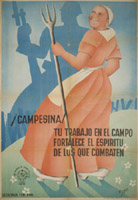 |
Campesina! tu trabajo en el campo fortalece el espiritu de los que combaten
[Farm woman!! Your work in the fields strengthens the spirits of those who are fighting.]. Fergui. Partido Comunista de España, Comite Provincial de Madrid, Secretaria de Agit-Prop Lithograph, 3 colors; 100 x 70 cm
|
|
This poster is geared towards women and, like many others, this poster emphasizes the essential connection between the war front and the rearguard. Historian Mary Nash, in her book Defying Male Civilization: Women in the Spanish Civil War, that many posters used or implied the slogan: "Men to the Front. Women to the Homefront." The parallels between the front and the rearguard are emphasized by the way in which the stance of the woman is mirrored by the shadow of a soldier behind her. Notably, the shadow of her pitchfork is a rifle. Such parallels are common among civil war poster of Republican Spain, which employ text with political overtones or make direct comparisons between the tools of production and the weapons of war. As Mary Nash notes, women were often encourage to join the "production front," to occupy the "production trenches" and to become the "vanguard of production."
As the war pulled most of the male members of Republican Spain to the front, women filled the vacancies in both the fields and the factories. In the first half of the 1930s, the presence of women in the workplace had been a point of contention. Supporters of a cult of domesticity and strict separation of the private and public spheres were particularly hostile to women's wage labor. In all likelihood, this movement was a response to the fact that women had already begun to work for wage labor. During the war, this issue ceased to be a problem especially since women laborers were needed to keep the Republican industrial and agricultural economy going. Nonetheless, women still met resistance to their integration into the labor force during the war. This resistance was countered by women's group the stressed the need for women on the home front. The division between city and countryside was a key axis of the question of women's labor. It appears that much of the conflict over women's labor occurred mostly in cities especially those with significant industrial sectors. Public opinion and women's opinion about female agricultural laborers needs additional research in order to know more about women's experience of working in the fields during the civil war.
Aside from the fact that Fergui commonly worked for the Asociación de Amigos de la URSS (Association of Friends of the USSR), little is know about the artist who signed this poster.
|




